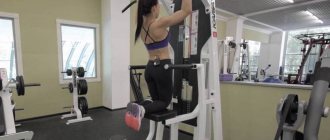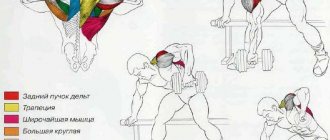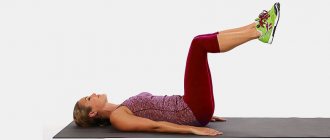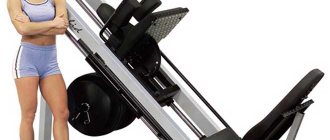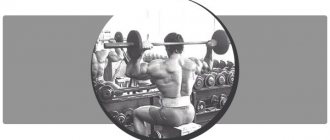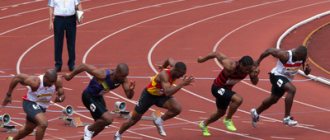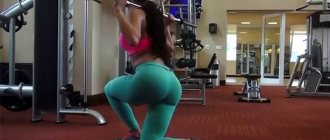Classic
Many experts call these types a direct grip. But in fact, this is a classic that is familiar to many from physical education lessons at school.
The fact is that this particular execution of this exercise gives a very diverse load on different groups, arms, forearms. The triceps are also involved in the work, but the biceps do not work very well with this arrangement of the arms, it follows that the training works mostly on the general physical condition of the entire shoulder girdle.
The classic position is considered not very comfortable for the athlete, if we take for comparison, for example: the placement of the palms in one’s direction. A similar exercise in bodybuilding can be considered the biceps barbell press, but here the back muscles are not involved in the work.
The following conclusions can be drawn about the work of muscles in this training:
- Back, if you make the grip narrower, then the main load is taken by those located below;
- Biceps, the lateral part most often works, and which is located inside;
- Triceps remains in secondary roles;
- Shoulder, before training on the horizontal bar, this part of the body should not be loaded, otherwise there will be no result;
- Forearm, the same advice as for the shoulder, since with exhausted muscles it will not be possible to do it technically correctly and the required number of repetitions.
It is worth especially noting that all of the above applies to exercises on the horizontal bar with a straight grip with your hands shoulder-width apart.
Muscle work on the horizontal bar depending on the grip
Let's start with the simplest, two grips that we have known since childhood:
- - Frontal or “regular” grip - the palm faces in the direction of your gaze. With this position of the hand, the work is redistributed between three muscle groups at once: the biceps, the anterior bundle of the deltoid muscle and the muscles of the forearm. Thus, this particular grip is ideal for uniformly pumping all muscle groups of the arm, but is not suitable for a forced strike on one or another muscle group;
- - Reverse grip - the palm is turned towards us. We have known about which muscles work when doing pull-ups with such a grip since childhood and physical education lessons. Of course, this is the biceps, which contracts to almost 80% of its possible potential, and also, to a lesser extent, the upper pectoral muscles and the anterior deltoid. But there is one secret that will allow your biceps to contract 100%, which few people know about.
But that’s not all, and there are a couple of other grips that, to one degree or another, better involve various stabilizer muscles in the work. These are horizontal and various inclined grips on special horizontal bars, which allow you to focus on the latissimus dorsi muscles, largely excluding the forearms, shoulders and chest from the work.
Also, in addition to the grips, there is another factor that affects which muscles work when pulling up, and this is the width of the arms, which we will talk about later.
Positioning of hands and emphasis on muscle work when pulling up
Everything here is quite simple, but so that you, my dear readers, have no questions left, I will describe everything using specific examples, and only then draw the appropriate conclusions. So, here we go:
- - Narrow grip - palms actually touch each other. This grip allows you to include the top of the lats and the outer head of the biceps in the work, but in no case should you pull yourself up in this way using a regular grip, as this will put a colossal load on the wrist joint;
- — A regular grip is, in fact, an ideal balance in the work of the arms and back. With a reverse grip, the internal biceps curl works great, while with a regular grip, the main emphasis is on the back muscles. Here you can experiment with the position of the thumb in both positions of the palm, as this will increase the amplitude of movement, and therefore the degree of muscle development.
- — Wide grip – anything wider than shoulder width is considered a wide grip, and for good reason. After all, it is this grip that symbolically develops the latissimus dorsi muscles, practically reducing the work of the arms when doing pull-ups to zero. Under no circumstances should you use a reverse grip because of possible joint injuries.
And of course, I would like to separately say that all these characteristics, rules and advice are quite average. Using them, your first priority is to feel your muscles working on the bar. Of course, if you took on the bar for the first time in many years, then you will have to spend some time preparing, but when you can do more than ten pull-ups with a regular grip, you know that your finest hour has struck
The time to start experimenting is when you have squeezed everything you can out of your normal grip, but you need to do this carefully, without jerking or swinging. Many will ask - why? Everything is elementary, because those parts of the muscle groups that are included in the work when doing pull-ups on the horizontal bar with grips that are unusual for you are not accustomed to the load that you are immediately trying to impose on them. Consequently, such zeal can easily lead to tearing of muscle tissue, and this, believe me, is not worth it
Consequently, such zeal can easily lead to tearing of muscle tissue, and this, believe me, is not worth it.
What begins to develop when performing push-ups on parallel bars
When performing such an exercise, as in the standard position, most of the groups that are located in the upper body are included in the work. It is worth noting that parallel bars exercises are quite effective and allow you to qualitatively develop your body in a short time.
Bodybuilders consider this exercise universal, since almost the entire body works at the same time. When this exercise is performed, the following sections are pumped up the most:
- Large chest
- Triceps
- Deltoid group
Here, unlike pull-ups, when the main emphasis is on the biceps and latissimus muscles, the focus is on the chest and triceps. In this case, the applied force can be seriously changed depending on how you position your arms and body. The width of the beams also plays a rather important role
The width of the beams also plays a rather important role.
If the body is slightly tilted down and forward, then the greatest efforts will be made by the thoracic regions of all types. When performing the exercise, your legs should be bent at the knees. Due to this, the applied impacts will increase significantly, which will increase the efficiency of working on your body.
If you put it in a vertical position and straighten your legs, then mainly the triceps will work. With the elbows as far away from the body as possible, it will be possible to get a strong impact on the thoracic region
The closer the elbows are to the body, the more attention will be paid to the triceps. Before starting push-ups, the bars are adjusted so that they are positioned exactly shoulder width apart
If the hands are too close to each other, then the maximum indicators will be observed on the triceps muscle. All others will not work efficiently enough. When performing dips, the entire body is subject to a very serious impact.
If the exercise is mastered correctly, it will give a serious impetus to development when performing all pressing movements. Due to such push-ups, you can form a very attractive chest relief in the shortest possible time; this is done much faster compared to traditional push-ups from the floor.
The fact is that all the pectoral muscles are pumped here, and special mention should be made of the lower chest, which allows you to give the figure precise and clear contours. Push-ups have a positive effect on posture and allow you to straighten your shoulders. This method of pumping up your chest is one of the cheapest, since there is no need to use various exercise equipment, because all the necessary equipment can be found on an ordinary street sports ground.
https://youtube.com/watch?v=4W_wEHbZvkk
What muscles work when pulling up[edit | edit code]
This complex exercise requires the joint work of several muscle groups and includes movements in two joints (shoulder and elbow). When doing a pull-up, you first use multiple muscles in your hands and forearms to grab the bar. Strengthening them is of great importance for performing various everyday tasks - both for working at the computer and for doing physical labor. Then you engage the large paired muscles of the shoulders, shoulder girdle, and back.
LATISM DORSI
. They play an important role in performing pull-ups. They are responsible for rotating the arms in the shoulder joints inward, towards the center of the body, for moving the arms towards the center of the body and back, behind the back. In addition, they play a synergistic role in stretching and flexing the lumbar spine in any direction. In sports jargon, this pair of muscles is often called wings.
TRAPEZIUS MUSCLES
. They also play an important role in performing pull-ups. This is a pair of large superficial muscles that stretch from top to bottom from the base of the skull to the middle of the back and laterally from the thoracic vertebrae to the shoulder joints. Their main function is to move the shoulder blades and support the arms.
FOREARM FLEXORS AND EXTENSORS
. The muscle structures between the elbows and wrists include a large number of muscles, including the finger flexors and extensors, brachioradialis (flex the elbows), pronators (turn the palms down), and supinators (turn the palms up). These are the muscles that allow you to grip the bar.
BICEPS
. One of the auxiliary muscles involved in pulling up. Responsible for rotating the forearms and bending the arms at the elbows. They are located on the front side of the shoulders. The biceps are best worked with reverse grip pull-ups.
MUSCLES OF THE MIDDLE BODY
. This group of muscles consists of the rectus abdominis (the six quadrants called the abdominals), the obliques, the transverse abdominis, and the erector spinae. This area is the source of functional movement throughout the body and provides stability during exercise, including pull-ups, and maintains correct posture while standing and sitting. Strong midsection muscles are absolutely essential to maintaining good physical fitness, as body strength must be built on a strong and reliable foundation.
DELTOID MUSCLES
. They are responsible for the attractive sloping contour of the shoulders and consist of three beams: front, side (middle) and back. Pull-ups, although not the main exercise for developing the deltoid muscles (with the exception of their posterior bundles), still significantly strengthen them
PULL-UP RECORD IN 3 MINUTES (MEN): 100 Ngo Xuan Chuyen (Vietnam) 1988, “The Strongest Soldier in Vietnam” competition
3 MINUTE PULL-UP RECORD (WOMEN): 67 Elicia Weber (USA) July 28, 2009, Claremont, Florida
In the USA, the President's Council on Physical Culture and Sports has established the following standards for performing pull-ups on the bar: Men: norm = 8; excellent = 13; Women: norm = 1; excellent = 8.
Problems when pulling up
Anything can happen during pull-ups, and most often injuries occur, calluses form, and joint pain appears. Another problem is a weak grip, which sometimes causes falls. Those for whom pull-ups and horizontal bars are the norm are especially familiar with this.
Injuries
Getting injured is not that difficult. It is enough not to warm up before doing pull-ups or to jerk sharply during the exercise. The most vulnerable muscles are the brachialis and biceps. Take care of them.
Your shoulders can get hurt during muscle-ups as you try to lift yourself over the bar. The injury is very unpleasant and long-lasting. If you plan to do some elements on the horizontal bar, warm up the necessary muscles very well.
Calluses
Each person's skin condition is different. In girls, for example, a callus can form from an ordinary barbell weighing 20 kg. What can we say about pull-ups?
In men, depending on their weight, calluses may form already during the first workout. This happens because the skin on the palm gets pinched during the exercise. In such cases, sports gloves come to the rescue. They will significantly reduce the chances of blisters forming, and will also help you better grip the bar.
Pain
Most often, elbows and shoulders hurt during pull-ups. And it’s not just muscles or tendons that cause pain. But also ligaments, and the joints themselves. If you are worried about pain, consult a doctor, get an MRI or undergo another prescribed examination. An accurate diagnosis will help preserve health and minimize loss of fitness.
Falls from the horizontal bar
People fall from the horizontal bar for two reasons: a weak grip and wet hands.
The first problem can be solved by high-quality training of the wrist muscles. And the second - with gloves or powdered magnesium. Gloves will make doing pull-ups much more comfortable.
The grip can be strengthened by hanging on the horizontal bar for a long time. This will prepare your body for pull-ups.
Recommendations for implementing pull-ups with a narrow parallel grip
- Pull-ups are performed as the first exercise in a back workout as an alternative to other pull-up variations. It also makes sense to include this exercise as an additional exercise after straight wide grip pull-ups.
- The exercise can be performed with weights.
- If the gym does not have a special horizontal bar, you can do pull-ups on the horizontal bar sideways, holding it with one hand and placing the other palm further.
There is also an option to perform it on parallel bars or using a V-shaped handle.
- The execution scheme is simple. For optimal load and efficiency, 3-4 sets of 8-12 repetitions each will be enough.
- If you perform this exercise in combination with other pull-ups, 2, maximum 3 approaches will be enough.
- By the way, the exercise is reminiscent of working in a lever simulator. If parallel pull-ups are present in the training process, then the lever pull can be neglected.
The benefits of pull-ups on the horizontal bar for men
- Thanks to the exercise, you can develop your back , the grip features can increase the muscles in width or thickness, thus suitable for the training process of every athlete.
- The versatility of the exercise allows you to develop several muscle groups at once, which together gives a powerful anabolic boost to the body as a whole.
The pull-up apparatus is available in any gym, on sports grounds, and, if desired, it can be easily installed at home.
What is the best way to pump muscles - with a direct or reverse grip?
The modern point of view on this issue does not give an advantage to one type of grip over another.
It is commonly said that if a direct grip is difficult, then it is better to practice a reverse one. Over time, the back muscles, trapezius and deltoid muscles will become stronger and make it possible to perform a straight grip.
If we talk about grip width, fitness instructors agree that the grip can be from narrow to medium, with a preference for the second option.
Watch the following video in which the famous fitness trainer D. Semenikhin talks about the muscles that sway when we pull ourselves up.
Sporpitis to help joints and speed up recovery
To recover more effectively after training, you can not only reduce the load and increase rest time. The following will help you regain your strength and replenish your energy reserves faster:
- gainers;
- BCAA;
- protein;
- glutamine;
- creatine
The following sports supplements will be beneficial directly for joints and ligaments:
- Hyaluronic acid. It is part of synovial fluid, which acts as a natural lubricant for joints and prevents friction of its parts against each other. We recommend that you study in more detail how hyaluronic acid is beneficial for joints.
- Complex chondoprotectors. Effective preparations, including components necessary for the health of joints, ligaments and bones. These are chondroitin, glucosamine, collagen, curcumin, etc. The balanced composition of the supplements allows you to provide the joints with all the necessary nutrients.
- Collagen. One of the most important components of ligaments, cartilage and bones. When taking collagen, joints become stronger and their mobility increases. The substance exists in several forms. Therefore, we advise you to study in more detail the question of which collagen is best for joints.
- MSM. Supports collagen synthesis in the body and participates in the production of proteins, and also strengthens bone tissue. Information about whether it is worth taking MSM for joints will help you understand the issue in more detail.
- Curcumin. A substance derived from turmeric that has strong anti-inflammatory properties. We suggest studying how curcumin is good for joints.
Introduction or why is it even necessary?
How to learn to do pull-ups? — A question that all newcomers to sports ask themselves. The pull-up is a very useful exercise, and given all the variations of this exercise, it is clear how wide a range of muscles are involved in the pull-up. If you want to become strong, or get your body in order, pull-ups are a must!
The training will consist of three stages:
- Preparing for pull-ups
- Work on the crossbar
- Pull-up
All stages consist of lead-in exercises. Their complexity increases gradually.
Preparation
In order to do a pull-up on the bar, you must hang confidently on it, and for this you need to work on your forearm and grip. This can be done using a wrist expander, push-ups, or lifting objects of unusual, awkward shape.
Regarding the expander, it should not be too hard, so that you can fully close it up to 20 times. This way you will train not only grip strength, but also grip endurance. Circular rotations of the hand with a closed expander are useful. If the expander is too hard for you, the risk of injury increases.
Push-ups are next. We will be more interested not in the full-amplitude push-ups themselves, but simply in the push-up position. But during the stand, change the position of your hands, sometimes a wide grip, sometimes a narrow one, raise one hand up, and hold on to the other (up to 4 seconds), try to jump on your hands, while they should bend a little.
Also change the type of stance in support, on your fists, on your fingers (I won’t recommend on the outside, because it will cause pain), position yourself so that your bent thumb is in a vertical position, and again accompany all this by changing the position of your hands . Also, if you can, do push-ups in these positions.
Work on the crossbar
If you can hang on the bar for enough time, feel free to proceed to this stage. It is the completion of this stage that will lead to the long-awaited tightening. As you understand, the exercises of this stage will be performed on the crossbar.
- The first exercise is “Arm Changes”: Hang on the bar and move your hands from left to right and vice versa.
- Exercise two - “Grip Changes”: Hang on the bar and alternately change your grip from normal to lower (biceps grip) and vice versa.
- Exercise three – “Jumping with pull-ups”: Jump into the bars and pull yourself up. Constantly reduce the force of the jump and increase the load on your arms.
- Exercise Four - “Assisted Pull-Ups”: You need a friend who will help you as you do pull-ups. It looks like this: you hold onto the bar and begin to pull yourself up, your friend holds your legs and moderately helps you. The help should not be strong, because otherwise the exercise will lose its effectiveness.
- Exercise five - “Hang”: You need to get to the top point of the pull-up and stay there for as long as possible.
- Exercise six – “Hanging with lowering”: Pause at the top point of the pull-up and lower yourself, making every effort to do it as slowly as possible.
The main thing is dynamics!
After some period of completing the two previous stages, you will be able to catch up. Your first pull-up will be far from perfect technically, but that's okay. The main thing is to correct yourself later, to pull yourself up correctly in your interests.
A correct pull-up is full amplitude, uniformly accelerated, without jerking or using unnecessary muscles.
https://youtube.com/watch?v=-RlWclWm-I8
General rules for pull-ups
Like any physical exercise, pull-ups, if performed incorrectly, will be ineffective and can lead to injury. Before climbing the horizontal bar, you need to warm up your muscles. Do bends and swing your arms.
The pull-up is performed smoothly and without jerking. You don’t need to chase the number of repetitions; it’s better to do less, but correctly. When completing the upward movement of the body, the chin should be above the bar. The body should be positioned vertically.
It is extremely important to monitor your breathing. On the way up you need to inhale, on the way down you need to exhale.
This promotes proper muscle function.
Straight grip
The most common way to do a pull-up is with a straight grip. Usually, when passing various standards in school and the army, it is precisely these pull-ups that are counted. At the same time, it is the easiest to learn and is recommended for beginners.
When performing a straight medium grip, it is necessary to lift the body by working the arms and bringing the shoulder blades together. You need to touch the crossbar with your chest. While lowering, you need to try to stretch the muscles a little, this will make the next repetition easier.
When performing a narrow straight grip, you need to bend your back. At the top point, you also need to touch the horizontal bar with your chest
One of the most difficult pull-ups to perform correctly is the wide-grip pull-up. When doing this, you need to bend your back, squeeze your shoulder blades together as much as possible and relax your biceps. With its help, you can pump up your back muscles well, since lifting the body is accomplished only through their work.
Reverse grip
With this type of pull-up it is possible to pump up your biceps and back muscles.
This is a fairly simple type of pull-up, but if you do it completely correctly, the load on the muscles is quite good.
To perform a narrow reverse grip, approach the horizontal bar and grab the bar from below. Try to pull yourself up as high as possible. Ideally, you should touch the bar with the middle of your pectoral muscle. The body should be positioned vertically. This method works the biceps and pectoral muscles.
When pulling up with a medium grip, the main tension falls on the biceps, trapezius and back muscles. This pull-up is performed in the same way as the previous one. The difference is in the position of the body. When performing the exercise with a medium grip, you need to bend your back.
Other types of pull-ups
A wide head grip is used much less frequently. The exercise is difficult and requires good mobility of the shoulder joint. A neutral grip combines the features of different grips and allows the muscles to develop evenly.
Workout clothes
The main criterion for clothing for turnstiles is that it should be comfortable and not interfere with movements. This could be an ordinary tracksuit, a T-shirt; many people practice naked torso in the summer. Shoes should not be massive.
In winter, if you work out outdoors, you shouldn’t have too much clothing. Thermal underwear is suitable, over which you can wear a turtleneck or tracksuit. Gloves can be worn as desired and necessary; many even train with bare hands in winter.
Pull-ups are a good way to get your body in shape. After mastering pull-ups, you can begin to learn more complex exercises.
Exercise technique
Despite its apparent simplicity, head pull-ups are a rather insidious exercise. You can do it with ease, but not experience any benefits from it in terms of strength and muscle gain. Why? Because such a specific trajectory of movement requires extreme concentration on muscle contraction and stretching and well-developed neuromuscular connections. Without these two components, you will only pull yourself up using your biceps. Therefore, there is no need to force things and wait for an immediate effect from this exercise. It will not happen. It’s better to be patient and use wrist straps, only then will you learn how to properly pump your back with this exercise.
So, the technique for performing head pull-ups is as follows:
- Grab the bar with a wide grip. Your hands should be slightly wider than your shoulders. Move your head forward slightly so that your upper back is completely straight. There is no need to throw your neck back or lower your head too much. In both cases, the cervical spine will not thank you for this.
- As you exhale, begin the upward movement. As you rise, try to squeeze your shoulder blades together so that the muscles of your back, not your arms, are involved in the work. At the same time, try to keep the trapezoid in static tension. Continue to pull yourself up until there are a few centimeters left between the back of your head and the bar.
- Smoothly lower yourself down, spreading your shoulder blades out to the sides as you lower. At the bottom point, straighten up completely, allow the latissimus dorsi muscles to stretch properly and repeat the movement.
Pull-ups exercise description
Many professionals consider pull-ups to be an essential exercise for building a broad back. On the site you see a pull-up video that shows the correct pull-up technique. There are basic rules that will help you when performing this exercise, although the types and methods of pull-ups may vary.
Don't do any other exercises before doing pull-ups. Do pull-ups at the beginning of your workout. Otherwise, the muscles involved in the pull-up - biceps, latissimus dorsi and forearms - will be fatigued, and you will not get the desired result. Pull-ups are a fairly heavy exercise that require a lot of strength, so it's best to do them while you're fresh. You can compare the results when performing this exercise at the beginning and end of the workout: the resulting number of pull-ups will be a good indicator of the effectiveness of the chosen approach.
Many professionals do not recommend using wrist straps. Performing pull-ups without them allows you to strengthen your grip and develop strength in your forearms. It is recommended not to use wrist straps for the first two sets. In this case, there may be a slight decrease in performance, but the results will return to their previous level as grip strength increases. For those who have an extremely weak grip, who cannot do even a few pull-ups without wrist straps, of course, they will have to be used.
When performing pull-ups, it is better to use a “fingerless” grip - in other words, all fingers, including the thumbs, should be located on top of the bar. This grip will allow you to use your hands as hooks, transferring tension to the latissimus dorsi and reducing the role of the biceps, which are the weaker link. This grip will take some time to master, but once you get used to it, you will be able to feel the greater effect of lat pull-ups.
Don't do half pull-ups. There is a widespread misconception that such a pull-up is somehow better than nothing at all. If you don't fully contract your latissimus dorsi, which is only possible by lifting your chin above the bar, then you are not doing a pull-up in any way. It's better if your pull-up program includes 4-5 full reps than 10-12 partial reps. At a minimum, try to keep your upper arms parallel to the floor at the top of your range of motion with your elbows out to the sides.
Do not seek outside help. The maximum benefit from the exercise is obtained only when you do it yourself. Using machines that help you lift yourself to the bar with your legs will not give the desired result - the back muscles that swing during regular pull-ups are not used in these cases. The partner helping you rise to the top point is the same simulator, only in a manual version.
Avoid excess weight. Many athletes find that gaining mass helps with many exercises, but pull-ups are an exception - in the off-season, the gained fat serves as an additional burden. That's why professionals advise building more muscle in the off-season.
Finally, avoid any substitutions. You cannot achieve the pull-up effect using all kinds of blocks, dumbbells and lever exercise machines. You can evaluate the effectiveness of such exercises when you start doing pull-ups again. Any type of independent exercise (pull-ups on a horizontal bar, pull-ups on a bar) are exactly the exercises that will allow you to achieve the desired results in pumping up and expanding your back.
Find good health and an attractive body thanks to our bodyclub.pro system
Also see other exercises on Latissimus dorsi:
| Exercise | Projectile | Muscle group | Muscles involved | Popularity | Rating |
| One-arm vertical row (overhand grip, standing) | Dumbbells | Back | Latissimus dorsi | 235383 | 1167 |
| Pull-ups (close reverse grip) | Using body weight | Back | Latissimus dorsi | 182873 | 798 |
| Pull-ups (wide grip) | Using body weight | Back | Latissimus dorsi | 129283 | 388 |
| One-arm vertical row (overhand grip) | Dumbbells | Back | Latissimus dorsi | 120106 | 250 |
| One-arm vertical row | Dumbbells | Back | Latissimus dorsi | 108069 | 380 |
Copyright for this material belongs to the Fitness 96 portal. When reprinting, a link to the site www.fitness96.ru is required. Comments:
How many rest days should there be between workouts?
For example, at your last workout you overdid it and the next day you felt severe pain in your muscles, rather than moderate discomfort. In such situations, it is recommended to rest not even one, but 2-3 days.
Different muscles have different recovery times:
- 4-5 days – for large back muscles;
- 3-4 days – for medium muscles (deltoid);
- 1-2 days – small arm muscles.
Muscles become ready for stress only after proper rest.
Until the muscle pain goes away, it is not recommended to do pull-ups again. It is better to choose lighter exercises to speed up the removal of lactic acid from muscle tissue. It is equally important to combine pull-ups with exercises for other muscle groups: the abs and legs.
Another rest break depends on the pull-up technique. If it is complex and varied, then you should rest for at least 2 days. Beginners are recommended to pull themselves up from a “medium grip” position, when their hands are placed at shoulder level. Wide and narrow grips are more difficult, so they should be introduced in the future as you master simpler techniques.

